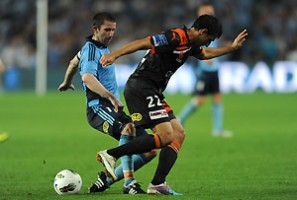An avalanche of goals but still some clean sheets to end the season: The A-League players who were the difference in Round 26
Joe Lolley was outstanding for the Sky Blues, scoring a brace as Sydney FC equaled their biggest ever victory.

Brisbane Roar rolls on and on to Australian sporting history – unbeaten in 33 games and 13 months. And yet we acknowledge their remarkable run, nod graciously, then focus more intently on other A-League sub-plots – Sydney FC’s revival, starlets Harry Kewell and Brett Emerton, Antony Golec’s tweets, Ben Williams’ cards, Gold Coast United’s crowds and more.
While there’s been much praise from within the football family for the Roar’s achievement, are we are truly appreciating the greatness we’re bearing witness to?
Keep reminding yourselves that Brisbane’s run is in a salary-capped league renowned for its competitiveness.
It’s a league in which it’s almost accepted that the reigning premiers/champions will fall from the penthouse to the basement as market forces rob the champs of their stars, as happened to the Roar.
Yet they’ve rolled on unabated. Such is the strength of the system that Ange Postecoglou has instilled at the Roar, the conviction and confidence they are playing with, that they seamlessly adapted to the forced changes in the off-season and loss of key personnel. The system is so strong that players are almost interchangeable.
Already this season they’ve brushed aside three of the clubs many thought could threaten their rule – Central Coast, Sydney FC and Adelaide United (and how – 7-1).
On the same weekend as the Roar took a point from their trip to Melbourne – the scene of their last defeat two Septembers ago – yet again coming back from a goal down within minutes, such is their mental strength, their youth team destroyed the Victory’s 5-1.
We are witnessing something special, at a club which had, until Postecoglou arrived, done very little to threaten the A-League establishment.
Perhaps the length of the run and the Kewell and Emerton sideshow heading into this season has overshadowed Brisbane’s feat, somewhat.
But there must be more to the under-appreciation of the Roar’s achievements. Consider their crowd average of under 13,000, below the league’s inflated (by Kewell’s Melbourne Victory) average.
Where are the 50,000 who witnessed the drama of last season’s grand final? And why haven’t they returned?
Roar undoubtedly suffered somewhat from the arrival of Gold Coast United on the scene, robbing them of a portion of their supporter base from the Queensland Roar days. And, as with most A-League clubs, there were some self-inflicted errors along the way that alienated many a football fan. For example, in the Roar’s case, the greatly inflated ticket prices that ate away at their crowd average.
If the Roar has come to symbolise the evolution and progression the A-League, they also represent some of the limitations that still hold it back.
In trying to explain why the team unbeaten in over a year, playing in and representing Australia’s third most populous city, can’t crack the easily achievable 13,000-mark, you can’t help but uncover some home truths.
Is it a coincidence that the Roar is playing out of the biggest stadium in the A-League, barely filling one-fifth of Suncorp; atmosphere lost amongst the barren banks of seats?
How can one the greatest runs in modern sport galvanise a city when the achievement remains hidden from view to two-thirds of the country – those without Fox Sports.
In a society where the cult of celebrity rules, is it any wonder Kewell’s Melbourne has doubled its crowd average (15,000-plus to 33,000-plus), while the Roar, a champion team rather than a team of champions, has barely increased its average by 3000.
It’s these factors that make the Roar the under-appreciated greats of Australian sport – on the one hand taking the A-League to a new level, on the other hamstrung by the league’s limitations.